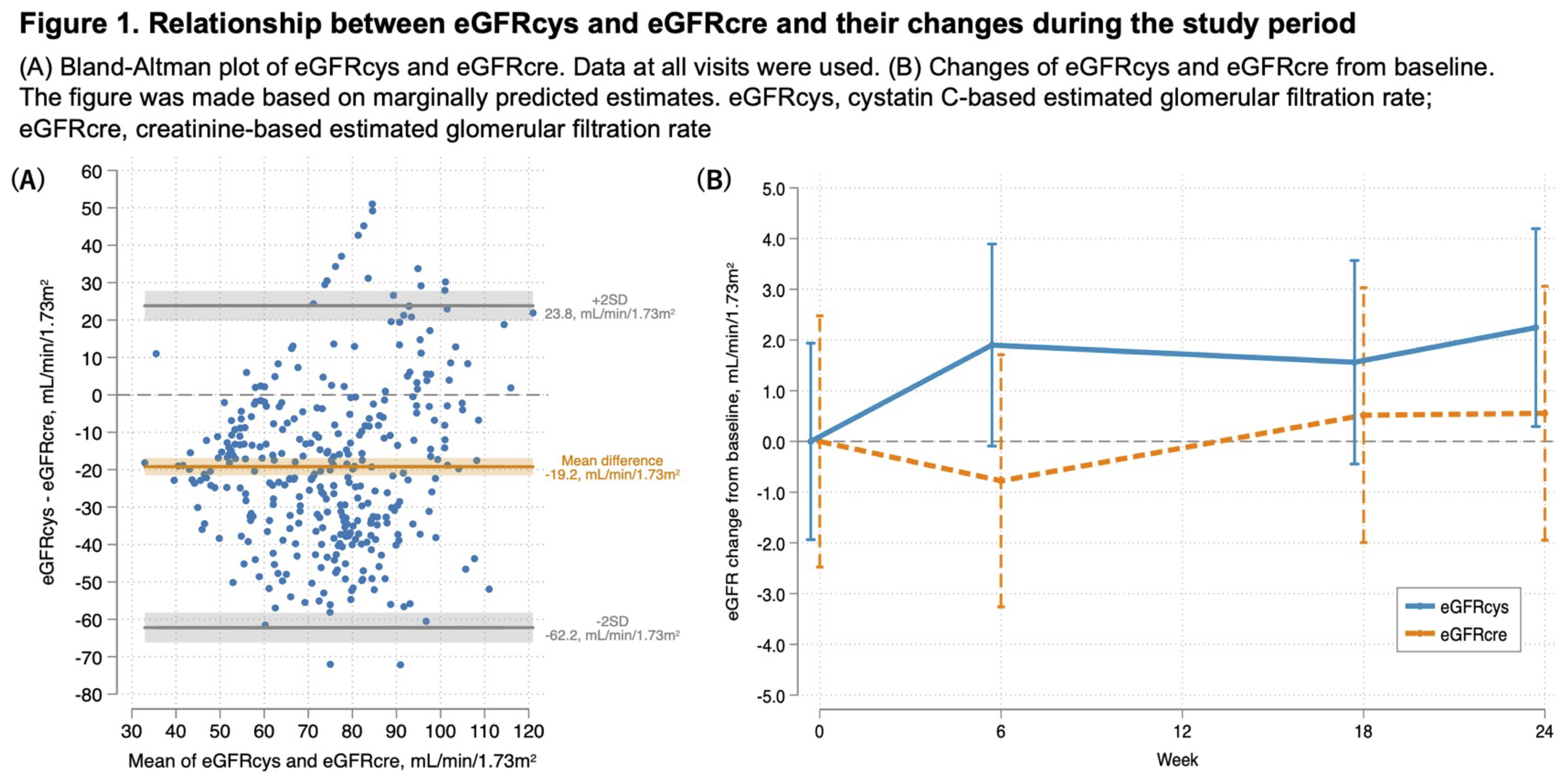Session Information
Session Type: Poster Session B
Session Time: 10:30AM-12:30PM
Background/Purpose: Glomerular filtration rate (GFR) is difficult to measure in patients with RA since creatinine-based estimated glomerular filtration rate (eGFRcr) may overestimate GFR due to sarcopenia. In contrast, systemic inflammation may decrease cystatin C-based eGFR (eGFRcys). However, these different eGFR measurements have not been fully studied in patients with RA. This study aimed to evaluate the differences between eGFRcr and eGFRcys, as well as the relationship between biomarkers and eGFRcys.
Methods: This is a secondary analysis of the TARGET trial. The TARGET trial found that RA treatment (TNFi or triple therapy) reduced disease activity and vascular inflammation in patients with RA over 24 weeks. Cystatin C, creatinine, and biomarkers associated with RA disease activity (VCAM-1, EGF, VEGF-A, IL-6, TNF-RI, MMP-1, MMP-3, YKL-40, Leptin, Resistin, SAA, and CRP) were also measured at baseline and at weeks 6, 18, and 24. This analysis utilized biomarker data and included participants whose cystatin C was available at baseline. First, we evaluated the differences between eGFRcys and eGFRcr using all visit data. Then, trajectories of changes in eGFRcys and eGFRcr over 24 weeks were examined. We assessed cross-sectional correlations between eGFRcys and log-transformed biomarkers at baseline. Then, correlations between eGFRcys change and changes in log-transformed biomarkers were examined. To consider intrapersonal correlation, mixed-effect linear regression with random intercepts and random slopes examined crude and adjusted associations between eGFRcys changes and changes in each biomarker. Multivariable models adjusted for baseline covariates, including baseline eGFRcys, baseline biomarker level, age, sex, race, body mass index, smoking status, non-steroidal anti-inflammatory drugs, glucocorticoid dose, methotrexate dose, hypertension, diabetes, and hyperlipidemia. We additionally adjusted for eGFRcr changes and baseline eGFRcr to examine whether these biomarker changes had additional value to eGFRcr change.
Results: A total of 120 eligible patients (median age 58 years, 73.3% female) were identified. The median RA duration was 1.6 years, and the median DAS-CRP was 4.8 at baseline. eGFRcys was lower than eGFRcr when we used all visit data (mean difference [95%CI]: -19.2 [-21.5, -16.9] mL/min/1.73m2) (Figure 1). eGFRcys tended to improve over time during 24 weeks of follow-up, while eGFRcr was stable (Figure 1). At baseline, eGFRcys was inversely correlated with multiple biomarkers, showing the strongest correlation with TNF-RI (r= -0.50) (Figure 2). eGFRcys change correlated with several biomarker changes. Multivariable mixed-linear regression models revealed that eGFRcys change was inversely associated with VCAM-1, IL-6, TNF-RI, YKL-40, and resistin (Figure 3).
Conclusion: These results suggest eGFRcys may change in response to RA disease activity, possibly independent of a true change in GFR. We need further research with measured GFR to determine whether eGFRcr or eGFRcys is a better estimate of GFR.
To cite this abstract in AMA style:
Fukui S, Inker L, Santacroce L, Giles J, Liao K, Bathon J, Solomon D. Kidney Function in Rheumatoid Arthritis: Estimating Glomerular Filtration Rate Using Creatinine versus Cystatin C in a Secondary Analysis of the TARGET Trial [abstract]. Arthritis Rheumatol. 2024; 76 (suppl 9). https://acrabstracts.org/abstract/kidney-function-in-rheumatoid-arthritis-estimating-glomerular-filtration-rate-using-creatinine-versus-cystatin-c-in-a-secondary-analysis-of-the-target-trial/. Accessed .« Back to ACR Convergence 2024
ACR Meeting Abstracts - https://acrabstracts.org/abstract/kidney-function-in-rheumatoid-arthritis-estimating-glomerular-filtration-rate-using-creatinine-versus-cystatin-c-in-a-secondary-analysis-of-the-target-trial/



